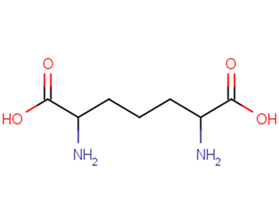
26-Diaminoheptanedioic acid
CAS No. 583-93-7
26-Diaminoheptanedioic acid( —— )
Catalog No. M19723 CAS No. 583-93-7
Diaminopimelic acid or DAPA is a lysine-like amino acid derivative that is a key component of the bacterial cell wall. DAPA is incorporated or integrated into peptidoglycan of gram negative bacteria and is the attachment point for Braun's lipoprotein (BLP or Murein Lipoprotein). BLP is found in gram-negative cell walls and is one of the most abundant membrane proteins.
Purity : >98% (HPLC)
 COA
COA
 Datasheet
Datasheet
 HNMR
HNMR
 HPLC
HPLC
 MSDS
MSDS
 Handing Instructions
Handing Instructions
| Size | Price / USD | Stock | Quantity |
| 100MG | 32 | In Stock |


|
| 200MG | Get Quote | In Stock |


|
| 500MG | Get Quote | In Stock |


|
| 1G | Get Quote | In Stock |


|
Biological Information
-
Product Name26-Diaminoheptanedioic acid
-
NoteResearch use only, not for human use.
-
Brief DescriptionDiaminopimelic acid or DAPA is a lysine-like amino acid derivative that is a key component of the bacterial cell wall. DAPA is incorporated or integrated into peptidoglycan of gram negative bacteria and is the attachment point for Braun's lipoprotein (BLP or Murein Lipoprotein). BLP is found in gram-negative cell walls and is one of the most abundant membrane proteins.
-
DescriptionDiaminopimelic acid or DAPA is a lysine-like amino acid derivative that is a key component of the bacterial cell wall. DAPA is incorporated or integrated into peptidoglycan of gram negative bacteria and is the attachment point for Braun's lipoprotein (BLP or Murein Lipoprotein). BLP is found in gram-negative cell walls and is one of the most abundant membrane proteins. BLP is bound at its C-terminal end (a lysine) by a covalent bond to the peptidoglycan layer (specifically to diaminopimelic acid molecules) and is embedded in the outer membrane by its hydrophobic head (a cysteine with lipids attached). BLP tightly links the two layers and provides structural integrity to the bacterial outer membrane. Diaminopimelic acid can be found in human urine or feces due to the lysis or enzymatic breakdown of gram negative gut microbes.
-
In Vitro——
-
In Vivo——
-
Synonyms——
-
PathwayOthers
-
TargetOther Targets
-
RecptorOthers
-
Research Area——
-
Indication——
Chemical Information
-
CAS Number583-93-7
-
Formula Weight190.2
-
Molecular FormulaC7H14N2O4
-
Purity>98% (HPLC)
-
SolubilityWater:Soluble
-
SMILESNC(CCCC(N)C(O)=O)C(O)=O
-
Chemical Name——
Shipping & Storage Information
-
Storage(-20℃)
-
ShippingWith Ice Pack
-
Stability≥ 2 years
Reference
1.Lida S . Gordonia otitidis sp. nov. isolated from a patent with externarl otitis[J]. Int. J. Syst. Evol. Microbiol. 2005 55.
molnova catalog



related products
-
Nonabine
Nonabine is a compound with strong antiemetic properties that can be used to prevent nausea and vomiting associated with cancer chemotherapy.
-
Berberrubine
Berberrubine has antitumor activity. Berberrubine dose-dependently inhibits IL-8 and MCP-1 protein levels in the media and mRNA expression of the cells stimulated with IL-1beta or TNF-alpha.
-
Hypaconine
Hypaconine is a C19-diterpenoid alkaloid isolated from Aconitum and Delphinium spp. It exhibits strong cardiac activity.



 Cart
Cart
 sales@molnova.com
sales@molnova.com


